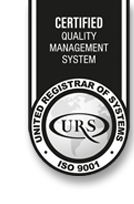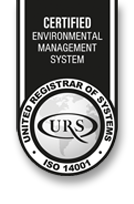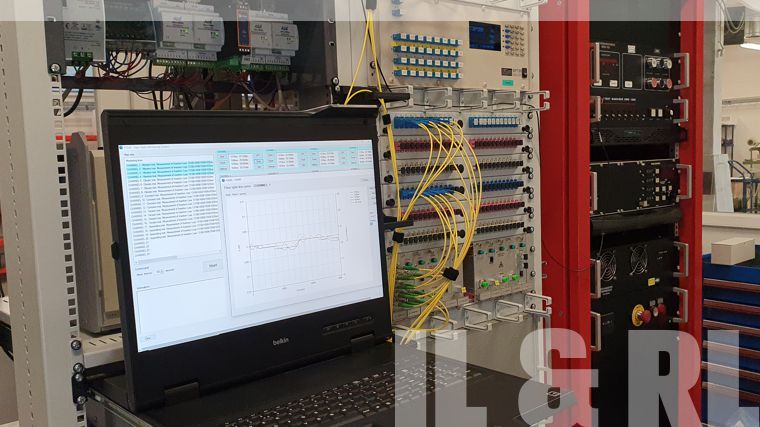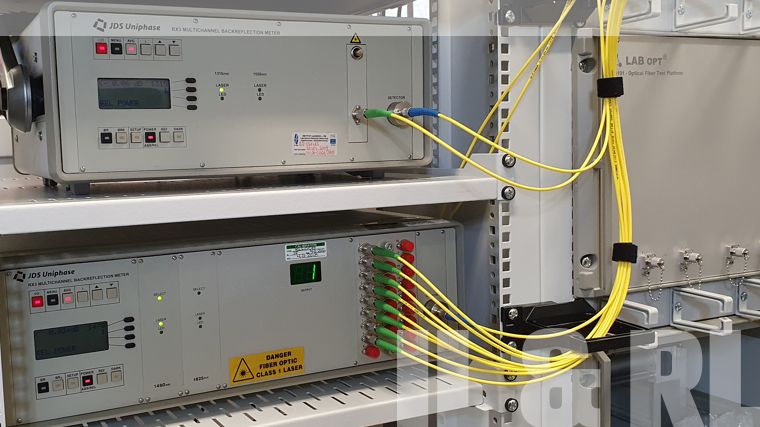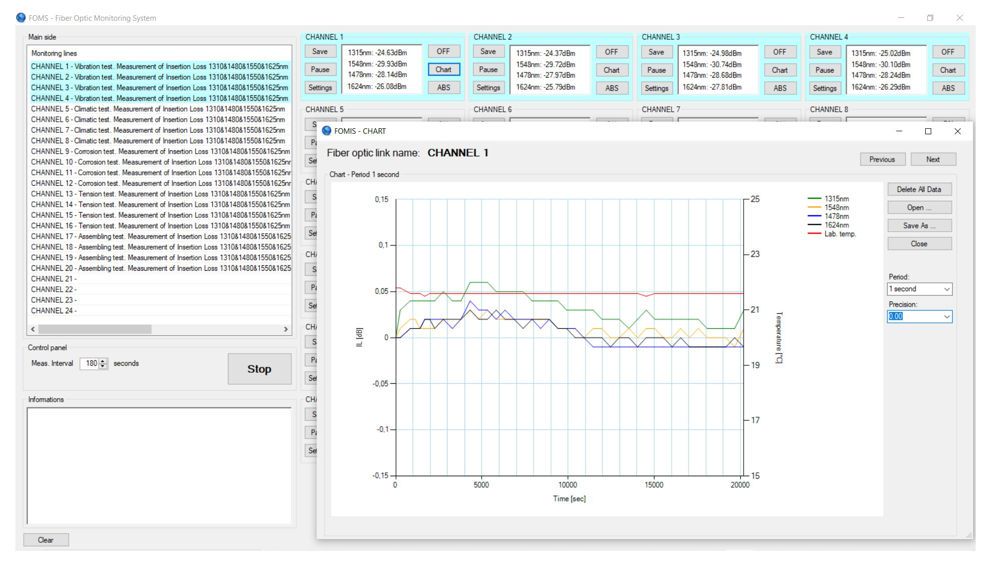LOSSES TESTS
One of the most important tests to which fiber optic splice protectors are subjected are optical power loss measurements. The power loss is quantified with a quantity called the attenuation, which is expressed in dB. One of the methods of determining the attenuation is a measurement method called insertion. In this method, the test products are placed between the light transmitter and receiver. During the measurement, the optical power that reaches the receiver after passing through the tested fiber optic splice protectors is determined. In our laboratory, we use RX3 multichannel optical multimeters from JDS Uniphase for this purpose. The system allows us to simultaneously monitor 24 channels on 4 optical wavelengths: 1310, 1480, 1550 and 1625nm. The devices measure the relative and absolute optical power and reflected power.
We use the system to test fiber optic splice protectors in accordance with the following requirements:
EN 50411-3-3 European standard
- Criterion 8.3.1: EN 61300-3-3; Change in attenuation: 1310&1550nm δIL ≤ ±0,1dB per circuit of 5 protected fusion splices
- Criterion 8.3.3: EN 61300-1-1; Vibration: 10-50Hz, amplitude 0,75mm, 15 cycles, 1550nm δIL ≤ ±0,2dB durin -, δIL ≤ ±0,1dB after – per circuit of 5 protected fusion splices
- Criterion 8.3.5: EN 61300-2-5, Torsion: magnitude of load 2N, rotation angle +/- 180°, 10 cycles, 1310&1550&1625nm δIL ≤±0,1dB after – per circuit of 5 protected fusion splices,
- Criterion 8.3.6: EN 61300-2-4, Fiber/Cable retention: magnitude of load 2N, 60s, 1 cycle, 1310&1550&1625nm δIL ≤±0,1dB after – per circuit of 5 protected fusion splices,
- Criterion 8.3.7: EN 61300-2-7, Bending: magnitude of load 2N, 5s, 1 cycle, 1310&1550&1625nm δIL ≤ ±0,1dB after – per circuit of 5 protected fusion splices,
- Criterion 8.3.8: EN 61300-2-17, Cold: -40°C, 96h, 1310&1550nm δIL ≤ ±0,2dB durin -, δIL ≤ ±0,1dB after – per circuit of 5 protected fusion splices
- Criterion 8.3.9: EN 61300-2-18, Dry heat: +80°C 96h, 1310&1550nm δIL ≤ ±0,2dB durin -, δIL ≤ ±0,1dB after – per circuit of 5 protected fusion splices
- Criterion 8.3.10: EN 61300-2-19, Damp heat: from +25°C to +55°C, 93%Rh, 4 cycles, 96h 1310&1550nm δIL ≤ ±0,2dB durin -, δIL ≤ ±0,1dB after – per circuit of 5 protected fusion splices
- Criterion 8.3.11: EN 61300-2-22, Change of temperature: from -40°C to +70°C, 12 cycles, 68h, 1310&1550nm δIL ≤ ±0,2dB durin -, δIL ≤ ±0,1dB after – per circuit of 5 protected fusion splices
- Criterion 8.3.12: EN 61300-2-26; Salt mist: concentration NaCl 5%, +35°C 96h 6.5÷7.2PH, 1 cycle, 1310&1550&1625nm δIL ≤ ±0,1dB after – per circuit of 5 protected fusion splices. Additionally, there are no noticeable significant differences in the appearance of the tested product, such as traces of rust, discoloration, deformation.
TS 0338/96 Deutsche Telekom standard
- Criterion 5.9.1: TS 0338/96, EN 61300-3-3; Change in attenuation after installation: 1550 δIL ≤ ±0,1dB after – per circuit of 5 protected fusion splices for criterions 5.9.2, 5.9.3, 5.9.4 i 5.9.5 and δIL ≤ ±0,1dB after – per circuit of 12 protected fusion splices for in other tests where the measurement of the change in attenuation is required,
- Criterion 5.9.2: DIN EN 61300-2-18, Dry heat: +85°C 96h, 1550nm IL ≤ 0,1 for 5 crimp protectors,
- Criterion 5.9.3: DIN EN 61300-2-17, Cold: -45°C, 96h, 1550nm IL ≤ 0,1 for 5 crimp protectors,
- Criterion 5.9.4: DIN EN 61300-2-19, Damp heat: +40°C, 93%Rh, 96h, 1550nm IL ≤ 0,1 for 5 crimp protectors,
- Criterion 5.9.5: DIN EN 61300-2-22, Change of temperature: from -40°C to +70°C, 12 cycles, 68h, 1550nm IL ≤ 0,1 for 5 crimp protectors,
- Criterion 5.9.6: EN 60068-2-6 , Vibration: 10-500Hz, 10 cycles, 1550nm IL ≤ 0,1 for 12 crimp protectors,
- Criterion 5.9.7: EN 60068-2-27, Shock: 11ms, half sine 15G, 1550nm IL ≤ 0,1 for 12 crimp protectors,

